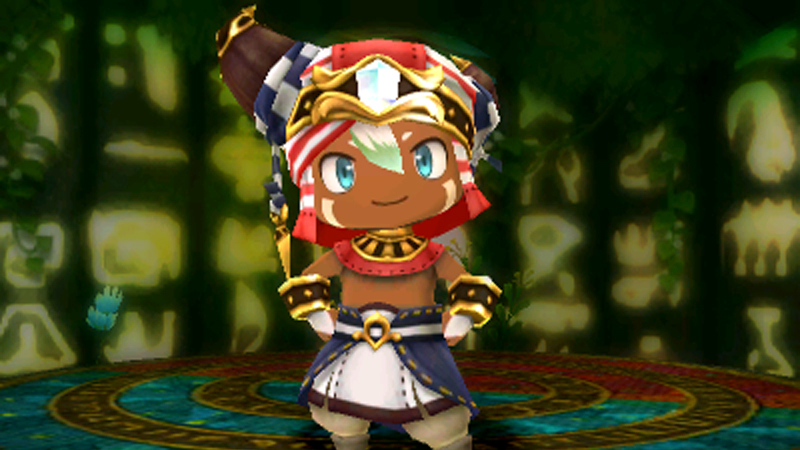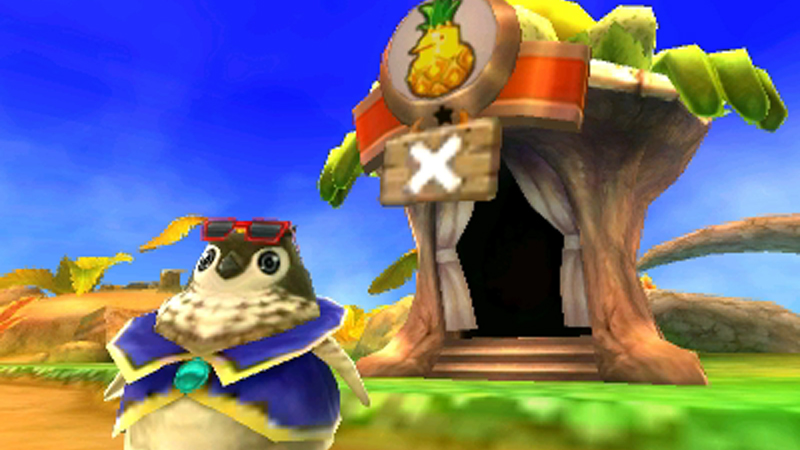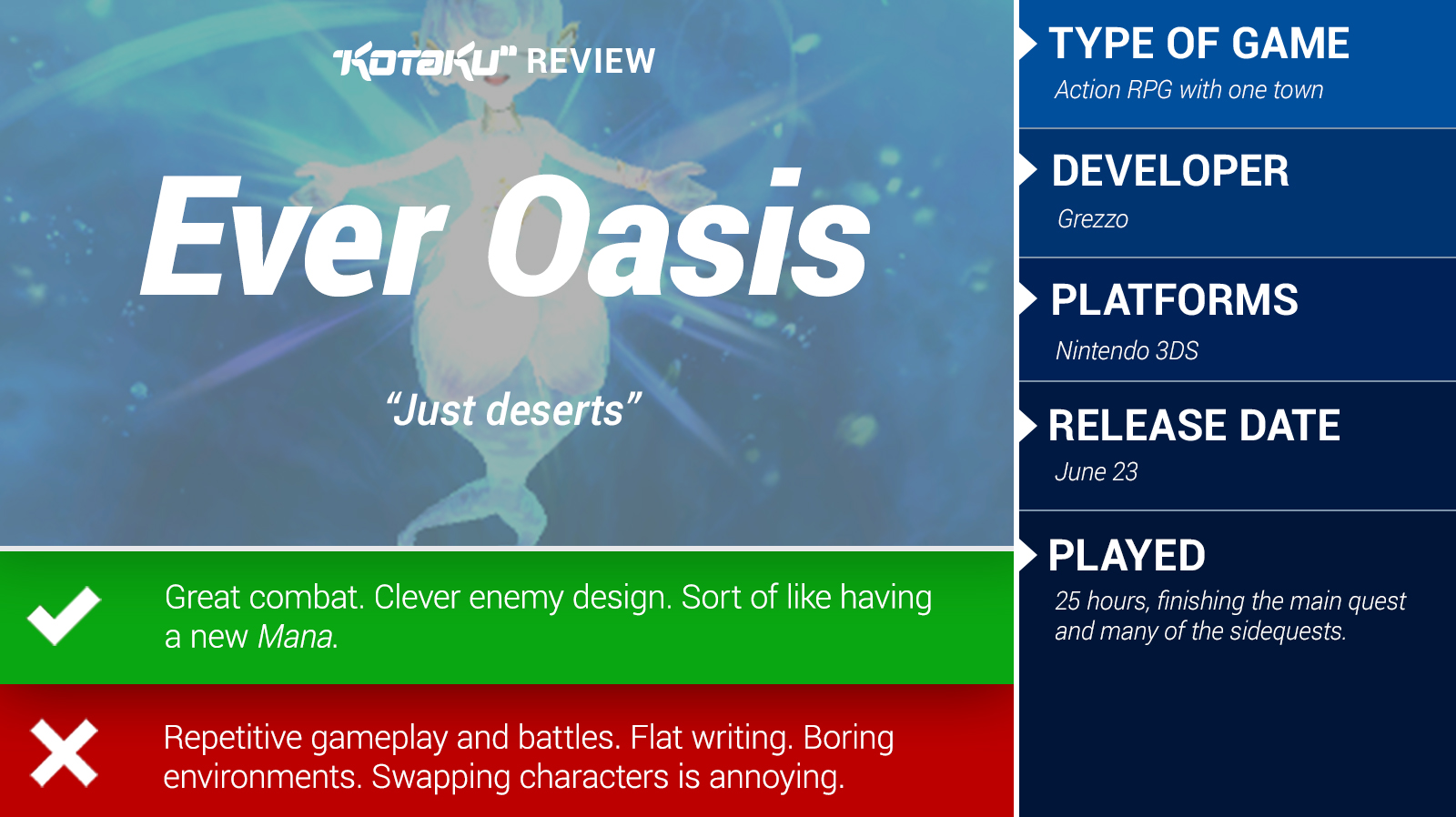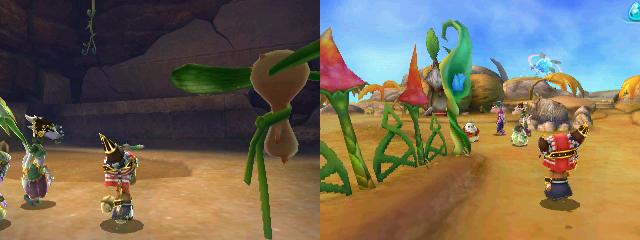The sad decline of the Mana series has been difficult to watch, and it’s equally unfortunate that its spiritual successor Ever Oasis suffers from similar problems — solid action RPG mechanics and moments of creative brilliance hampered by an experimental gameplay structure that drags everything down with it.
Ever Oasis is the latest 3DS collaboration between Nintendo and development studio Grezzo, which also created the remakes of Ocarina of Time and Majora’s Mask for Nintendo’s portable. Grezzo’s president is Koichi Ishii, who created the Mana series at Square, then produced the series until his 2007 departure. So it isn’t too surprising that Grezzo’s first big 3DS adventure is pretty damned Mana-like, for better or worse.
In one sense, it’s a fairly formal action role-playing game: Venture out into the world, find cute creatures, and hack and slash them to death. Your chances of victory in these battles is determined somewhat by your skill at twitch action, but mostly by grinding, levelling up, and finding better equipment.

The game’s two major phases are dungeon hacking (L) and oasis-building (R).
Here’s the twist: Kind of like Majora’s Mask, the game’s world is centered on a single hub town, the eponymous oasis, which serves as your home base. As you adventure, you’ll meet new characters, who will travel to your oasis to live there, and then open up shops, which you can place along your roads. As the oasis grows more populated and vibrant, your power in battle will increase, meaning you have to pay attention to both sides of the game to succeed.
It’s a daring concept, this marriage of Mana and Animal Crossing, but it doesn’t deliver on either front.
Let’s Slip Off To A Sand Dune
Koichi Ishii clearly has a thing for plants. Mana games are all about the relationships between humans and nature, with their god-trees and elemental spirits and whatnot. Ever Oasis wastes zero time making it clear that it does not intend to get off this ride. You play as a Seedling, a child of the great tree but not that one, and your best pal who helps you build the oasis is a friendly lady water spirit but not that one.
The most important thing that ties Ever Oasis to Mana is the fact that it’s an ARPG in which you swap amongst a party of three different members, each of whom has different weapons, skills and strengths. The game starts with a few hours that feel like Old Zelda, the kind Nintendo tried to get rid of with Breath of the Wild, in which the game won’t shut the hell up yammering at you about every little thing. After that, you finally get to go out into the world and start kicking some arse.

You can select either a male or female main character. Since they’re both just little adorable urchins who don’t talk, the only major difference is whether or not their hypothetical nipples are covered.
Ever Oasis‘ greatest strength is its combat. Locking onto enemies, dodge-rolling and striking all feels good, from the start of the game to the finish. If you get bored using the main character’s sword, you can swap to characters that use crossbows, hammers, spears, and a surprisingly wide variety of other weaponry. Your AI companions tend to hang back way too much, and so if a certain weapon is particularly effective against a certain enemy, it might be best to swap to that character so you can keep up a constant barrage of attacks.
Looking back on the whole game, though, I can’t help but notice that almost every single combat encounter plays out the same way: Dodge-roll around to the enemy’s back side, combo its butt until it turns around, then repeat. On the rare chance they have an area-of-effect attack, just stay out of its well-defined damage zone, then rush in and repeat. With very few exceptions, everything up to and including the final boss battle feels like the first battle with the tiniest rodent just outside the gates of your oasis.
I do like the enemy design, which is built around the corrupted-nature motif, so you have your rabid animals and your blackened evil plants. I especially like the guy who’s an effed-up pineapple. The graphic design is pleasing and colourful but lacks panache; the music too is inoffensive to the ears, but after 25 hours of listening to it I can’t hum any of it.
Cactus Is Our Friend
Before we go any further, here’s how the oasis works.
At first, it’s a simple place only inhabited by you and your water-spirit pal. Soon enough, visitors hear of your little slice of Heaven in the middle of the desert, and stop by to check it out. Fulfil certain conditions (which might be as simple as just stopping to chat with them, or, later in the game, involve several sidequests) and they will become a resident of the oasis.
Some residents will also be able to open a shop in town, which you can place on the road via a simple menu. You can’t buy things at these shops — your job is to keep the shopkeepers supplied with raw materials that they can turn into product, which then sells automatically, and you as the chief get a cut of the profits.

A “sold-out” sign hangs above a shop’s entrance, indicating you need to go find more goodies to restock it with.
How do you get this stuff? When you venture into the world, besides fighting monsters, you’ll also find cacti, pots and rocks, which you can smash for stuff. You also collect from monsters. When you return to the oasis you’ll be loaded down with doodads. As long as you’re pretty diligent about killing everything and breaking every crate, you’ll have enough to keep the shops going.
More shops attract more travellers, who create more shops, and so on and so forth. As you add residents, shops and such to your oasis, the oasis itself will level up. This increases the number of slots on your roads that will hold shops, but more importantly increases the HP buffs that your characters get when they venture out. In fact, most of your characters’ effective HP while in the field comes from the oasis, not their innate stats. So you really have to keep things happy and healthy in town to stand a chance in battle.
The fact that all of Ever Oasis‘ systems work together like this, in a generally balanced way, is to its credit. The problem is, the game does little to obscure the fact that you’re just grinding out collectables to keep the system’s gears turning. It isn’t fun to get a new resident for your oasis, since they all have the same personality, which is to say “milquetoast”. The dialogue is written with all the verve and audacity of a strand of cooked spaghetti. The sidequests are never surprising — it’s just go here, kill this, come back.

The lack of any sort of surprise, of unexpectedness, can really kill one’s motivation to keep going. It’s a repetitive game: The dungeons largely feel the same, and the oasis stuff is always the same, the 10 minutes of clicking and busywork you have to do to keep up the garden, restock the shops, and collect the cash between outings.
Killing enemies in the dungeons is certainly fun, although there’s one hang-up: Dungeons usually contain more than three different types of interactive objects that require more more classes of characters than you can hold in your party. That means you can’t bring in a party that can, say, mine for gems, dig stuff out of holes, poke sticks into walls, and shoot faraway targets. So at many, many points during a dungeon, you’ll find yourself warping back to the oasis (which you can do at any time), temporarily swapping out party members, then jumping back to where you were. It kills the sense of flow.
Ever Oasis is an intriguing blend of genres that serves as an interesting proof of concept, but is far too bland and repetitive to be a classic of the ARPG genre. And that’s too bad, because after a spate of similarly disappointing entries in the Mana series, I was hoping this spiritual successor would be better. I plodded through it, searching and searching for some kind of respite, something that broke out of the game’s loop of busywork. I never found it. As with most oases, this one turned out to be a mirage.

Comments
2 responses to “Ever Oasis: The Kotaku Review”
It sounds very similar mechanically to one of the most obscure, but most beautiful entries in the Mana series, Legend of Mana (for PS1). Sadly, I really cannot dig the low-poly 3D of this game compared to the gorgeous pixel art of Legend. (Seriously, get a load of this https://media.giphy.com/media/Jg9cdIPhzzl3W/giphy.gif)
Shame the first trailer showed lots of promise. I downloaded and played through the free demo yesterday and thought the combat and dungeons was really good but was disappointed with the town aspect as thought it would be more in depth. Ill probably still buy it I just might hold off for a little while
It was a beautiful game, and a lot of fun to explore the world, but the main story and most of the side stories are just depressing. There is NO theme of Redemption here and you MUST kill friends & family (with the sole exception of the animals corrupted by chaos that you just beat down are now clean and get to live free again – this strange juxtaposition gave me pause to wonder if the writers might be misanthropic environmental extremists to some degree). Absolutely ruined what was otherwise an awesome game (though also excepting the extremely repetitive grind of the end game). Recommended for lovers of Animal Crossing with a bent for adventuring, who can stomach all the depression.
I actually liked this a lot and had a lot of fun with it. I logged around 50 hours on in maxing out my oasis and I find the art design and music really engaging. The Egyptian aesthetic really worked for me. It was good.